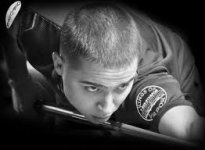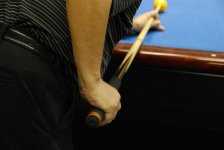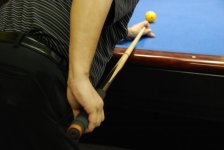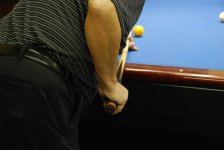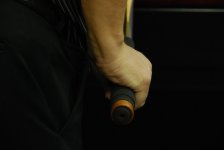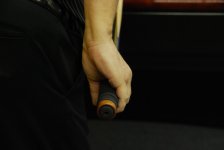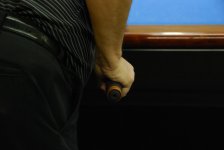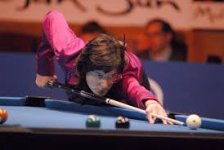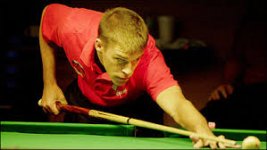You are using an out of date browser. It may not display this or other websites correctly.
You should upgrade or use an alternative browser.
You should upgrade or use an alternative browser.
How to Use the Masse' Shot to Curve Around Obstructing Balls
- Thread starter CJ Wiley
- Start date
A wrist flick is needed on some (few) shots such as the power draw or when the CB/OB are very close together. But the wrist is near the top of the list for causing stroke flaws.....crooked, off-line, etc. The wrist can flex, extend, deviate laterally/medially (ulnar/radial) and a combination of these movements (twist or curl, think Earl). Some players have fixed (pun intended) this potential problem by pre-cocking the wrist and thereby virtually eliminated movement (CJ (cocked in radial deviation), John Schmidt (cocked in ulnar deviation), Louie Roberts (cocked in extended position), Oliver Ortmann/Jimmy Reid (cocked in flexed position)), see pics. John talked about this in one of his pre-match TAR podcast. Otherwise, for all other players, on most shots the wrist should be preferably neutral (think Mike Sigel) and quiet (loose) and just "follow" where the weight of the cue and momentum (speed) of the stroke wants to take it (think Efren). If you want to use the wrist on many or most shots, good luck with that.
The elbow, on the other hand, can only flex and extend by using the biceps and triceps.......essentially the same every time without any deviation right/left/up/down, etc. If you hold the upper arm and forearm at a 90 degree angle (optimal position for a pool stroke) and then fully flex the elbow (full stroke), the skin of the forearm and bicep will touch each other at the same area every time.......you can't make it different if you tried. The only way to move this fixed alignment of the forearm/upper arm off their intended setup is to have unwanted movements of the joints above and below it........ ones that have a wide range of motion, the wrist and shoulder. For example, if the shoulder is internally or externally rotated prior to tip contact the forearm/upper arm will move automatically with it (together) right or left which will result in the stroke moving off the intended shot line. If the shoulder flexes (moves forward (down)) prior to tip contact the upper arm/forearm will go down automatically with it (together) and you'll miss hit in terms of height on the CB (elbow drop).......elbow drop is OK but only after contact.
DTL
View attachment 377249 cocked, radial deviation
View attachment 377260 cocked, extended
View attachment 377261 cocked, flexed
View attachment 377262 cocked, ulnar deviation
View attachment 377268 Neutral
Here's one for you that I would like you to put a name to... a friend of mine, that plays shortstop speed, has a textbook stance with one glaring exception. His forearm is at 90 to the floor, straight under his upper arm. However, his upper arm and forearm are not over the cue, but to the outside of it. He has his grip hand cocked inward towards his body so far that the back of his hand is almost parallel to the floor!
I'm pretty sure why he does it, but what name would you call that??
Hmm......I guess that would be the opposite of a sidearm stroke, lol. That's the thing, the relationship between the forearm and upper arm will always be the same (physically impossible to change it while holding a cue with both hands)........what's moving them (together) is the shoulder, either internal/external rotation (moves tip right/left) or forward flexion/backwards extension (moves tip up/down). And the flexion/extension of the elbow will be the same no matter what position the forearm/upper arm are set at (inward, vertical, or outward like a sidearm position). Now without a cue in the hands one can supinate and pronate the forearm and change it a hair.
Some right handed players that very left eye dominate do what your talking about to a certain degree, but not like your friend.....he's way in there! lol.
Yeah, his is extreme, more so than anyone I ever saw. Most people that prefer the cue to be where his is just angle the forearm to the body. For some reason, while learning, he didn't. ??
Some Elememnts to producing a 'Proper' Stroke. Part I
Not to go too far of topic, about the issue of, 'Maximum Effect with Minimum Effort!' This has been admittedly stated by many of my peers in the 3 Cushion World one of my most apparent assets for stellar play for so many years.
Partly with some 'Natural' hand-eye coordination and knowing the proper fundamental mechanics of a pure stroke. In which, timing, tempo, technique and cue-tip speed are the 'key' elements!
I am also, 'Left-Eye' dominate being right-handed, but, I do aim with 'BOTH' eyes at each shot. There are only a few rare instances where I favour one eye over the other when playing a shot!
Here are some images from my Book/DVD, 'The Concise Book of Position Play' demonstrating my Stance, Head Position, Grip position at address, backswing and Follow-thru.
These fundamentals serve me well even at nearly 70 years of age!


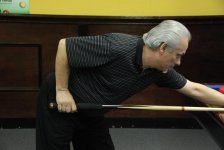
Not to go too far of topic, about the issue of, 'Maximum Effect with Minimum Effort!' This has been admittedly stated by many of my peers in the 3 Cushion World one of my most apparent assets for stellar play for so many years.
Partly with some 'Natural' hand-eye coordination and knowing the proper fundamental mechanics of a pure stroke. In which, timing, tempo, technique and cue-tip speed are the 'key' elements!
I am also, 'Left-Eye' dominate being right-handed, but, I do aim with 'BOTH' eyes at each shot. There are only a few rare instances where I favour one eye over the other when playing a shot!
Here are some images from my Book/DVD, 'The Concise Book of Position Play' demonstrating my Stance, Head Position, Grip position at address, backswing and Follow-thru.
These fundamentals serve me well even at nearly 70 years of age!



Last edited:
Nice pics.
To just comment on some things about your setup as it relates to what we've been talking about since about post #53, you're way above the cue therefore your shoulder is not as "coiled"......upper arm is essentially parallel to the floor. Nice 90 degree angle of the upper arm/forearm. I talked about pre-cocking the wrist a few post ago and yours is slightly cocked in radial deviation and in a slightly flexed position (3rd pic) as well. All good stuff.
Another thing that can cause stroke flaws/miss hits on the CB and not talked about in this thread is the grip (mostly fingers). I noticed that your index finger is slightly off the cue (2nd pic). I do this as well because I think it kinda gets in the way or inhibits a good back swing.
IMHO, you're absolutely 100% correct about the first finger, I think it helps to create 'Steering' when applying Extremely Effect. The 'V' formed by the thumb and first finger should be 'perfectly' in-line with your follow-thru line!
BTW, DTL, 90% of the TOP 3C players favour the, 'Full finger' grip, for complete control of the CB!
Last edited:
Nice insights in this threat DTL.I don't know jack about 3C, lol. But I respect the game, requires lots of skill and knowledge no doubt.:thumbup:
We did hijack the thread a little but don't think anyone minded. LOL
FWIW: I don't think the kind of power shots I've talked about come into the games very much, other than perhaps the 8 ball and 10 ball break, where power may assist, and the rare power draw. A basic technique should suffice, especially on comp tables.
So, back to coiling, it seems it is supposed to mean having the agonist muscles in the forward stroke near full extension... am I right?
One of the points in my breaking video is that more power can be produced when a muscle in nearer full contraction, hence, the shoulder position is MR3C's stance is actually more powerful, at lease in terms of immediate acceleration. Length of stroke comes into the equation too of course.
EDIT: Come to think of it, extending the shoulder agonists, pecs, delts and lats, which attach to the humerus, actually puts the biceps and forearm muscle agonists into a stronger position of contraction. So if one keeps the elbow high, this is a stronger position.
Would be interested in what you notice in the stroke of this guy, Judd Trump, possibly the best power snooker player there has been: https://www.youtube.com/watch?v=-L7UIWilR8g
Last edited:
Nice insights in this threat DTL.
We did hijack the thread a little but don't think anyone minded. LOL
FWIW: I don't think the kind of power shots I've talked about come into the games very much, other than perhaps the 8 ball and 10 ball break, where power may assist, and the rare power draw. A basic technique should suffice, especially on comp tables.
So, back to coiling, it seems it is supposed to mean having the agonist muscles in the forward stroke near full extension... am I right?
One of the points in my breaking video is that more power can be produced when a muscle in nearer full contraction, hence, the shoulder position is MR3C's stance is actually more powerful, at lease in terms of immediate acceleration. Length of stroke comes into the equation too of course.
EDIT: Come to think of it, extending the shoulder agonists, pecs, delts and lats, which attach to the humerus, actually puts the biceps and forearm muscle agonists into a stronger position of contraction. So if one keeps the elbow high, this is a stronger position.
Would be interested in what you notice in the stroke of this guy, Judd Trump, possibly the best power snooker player there has been: https://www.youtube.com/watch?v=-L7UIWilR8g
Very nice 'Pro-Mo' video, many of the strokes He used in this video are 'common' strokes in 'actual' game shots in 3C. Impressive for sure for a snooker player.
Both these gentlemen exude the essence of 'Minimum Effort for producing Maximum Effect!'
https://www.youtube.com/watch?v=frf2WGYAyWU&list=PL3iSSgXYgVcwJAf6NgWZOdGBU4eDw_6bh
Last edited:
The need for precision, and acceleration is vital in pool, so it's important to......
Yes, the coiling action is used in many games and sports. The need for precision, and acceleration is vital in pool, so it's important to at least understand how the coiling can happen.....or not.
Without the coiling motion it's tough to get leverage out of your stoke, so the power shots are "out of reach"......sometimes literally.
I understand the idea of coiling is a collecting or gathering of the muscles in and around the shoulder for a certain movement or even non movement. You're referring to positioning the shoulder, how?
You've mentioned this before , but we've never got any discussion going on about it.
Best,
Mike
Yes, the coiling action is used in many games and sports. The need for precision, and acceleration is vital in pool, so it's important to at least understand how the coiling can happen.....or not.
Without the coiling motion it's tough to get leverage out of your stoke, so the power shots are "out of reach"......sometimes literally.
As a teenager..........when you were 14, right? Are sure you didn't trip and hit your head on the rail when you were 14. :wink:
Hi Duke,
I thought you may have missed the wink after my facetious description.
I watched the 1st. half of your straight pool run last night when I had trouble sleeping. Fairly nice shooting after you got by that rattle/fall in the upper left corner. Is your table a Brunswick Sport King?
How long have you been playing & how long 'with' CTE?
Sorry for all of the questions but they all came to mind last night.
Best 2 You & All,
Rick
DTL; A little bit about how to achieve, IMHO, the 'Perfect' stroke.
Here's an excerpt from my Book/DVD, 'The Concise Book of Position Play.' I'm only presenting info on how to produce the proper stroke, not the 5 'Basic' strokes to achieve the thousands of effects needed to play 3 Cushion.
The Stroke and Follow Through
The past and present strokes in 3 Cushion Billiards
One of the most common faults of amateur players is the incorrect concept of the proper stroke and follow-through in 3 cushion billiards. Unfortunately years ago in the pre-modern game era, 30’s 40’ and 50’s, the equipment in the United States was vastly different. Modern tables are heated. Synthetic rubber is used for the cushions. Phenolic balls are used instead of Ivory and the woolen table cloth slowed the cue ball down more than today's cloth. The statement, “you must follow-through on all shots”, was misleading. The professionals of that era should have said, “Apply the proper follow-through for each individual shot”.
The modern game of 3 cushion billiards has evolved into a precision game. In order to achieve that consistent precision, you must have a stroke that is free from flaws. A certain amount of natural hand-eye coordination will give some player’s more consistent results. But the proper stroke and follow through can be taught to the level of any player’s natural ability.
The start of the proper stroke
The proper stroke starts in the pre-setup routine. After analyzing the position that waits for you, determine what kind of stroke is needed to achieve a point. Before the player addresses the cue ball, he needs to decide on the rhythm and tempo for that particular shot. Use a couple of warm up strokes to get the feeling.
When addressing the cue ball, the cue tip should be fairly close to the cue ball before you start your backswing. The player should learn to develop the same number of warm-up strokes on every shot. This provides the rhythm component of the stroke.
I personally believe in the continuous straight, horizontal and vertical stroke method, and not pausing. If the player interrupts the rhythm, he may lose the timing and tempo he was trying to achieve. Another very important part of the stroke is crescendo, (increasing speed), never decelerating. Just remember, whatever number of warm-up strokes you choose to take, embed that into your game.
Here's an excerpt from my Book/DVD, 'The Concise Book of Position Play.' I'm only presenting info on how to produce the proper stroke, not the 5 'Basic' strokes to achieve the thousands of effects needed to play 3 Cushion.
The Stroke and Follow Through
The past and present strokes in 3 Cushion Billiards
One of the most common faults of amateur players is the incorrect concept of the proper stroke and follow-through in 3 cushion billiards. Unfortunately years ago in the pre-modern game era, 30’s 40’ and 50’s, the equipment in the United States was vastly different. Modern tables are heated. Synthetic rubber is used for the cushions. Phenolic balls are used instead of Ivory and the woolen table cloth slowed the cue ball down more than today's cloth. The statement, “you must follow-through on all shots”, was misleading. The professionals of that era should have said, “Apply the proper follow-through for each individual shot”.
The modern game of 3 cushion billiards has evolved into a precision game. In order to achieve that consistent precision, you must have a stroke that is free from flaws. A certain amount of natural hand-eye coordination will give some player’s more consistent results. But the proper stroke and follow through can be taught to the level of any player’s natural ability.
The start of the proper stroke
The proper stroke starts in the pre-setup routine. After analyzing the position that waits for you, determine what kind of stroke is needed to achieve a point. Before the player addresses the cue ball, he needs to decide on the rhythm and tempo for that particular shot. Use a couple of warm up strokes to get the feeling.
When addressing the cue ball, the cue tip should be fairly close to the cue ball before you start your backswing. The player should learn to develop the same number of warm-up strokes on every shot. This provides the rhythm component of the stroke.
I personally believe in the continuous straight, horizontal and vertical stroke method, and not pausing. If the player interrupts the rhythm, he may lose the timing and tempo he was trying to achieve. Another very important part of the stroke is crescendo, (increasing speed), never decelerating. Just remember, whatever number of warm-up strokes you choose to take, embed that into your game.
It's a Brunswick Anniversary. Yeah, it has big pockets. The one's going through the gait of the pocket are forgiving, like the one shot you're talking about, but balls on or near the rail with anything more than medium speed are super tough as the pocket facings are like a pinball machine. So it evens out. I preface most all my vids saying I'm playing on a table with big pockets. You got 10 tries to run 50......for something cheap, say $500.By the way, the table is for sale.....mint condition and plays great.:thumbup:
Been playing for 48 years. As far CTE goes, almost 2 years. I don't use it on every shot. I've figured out a way to do the pivot or sweep at address by closing either my left or right eye depending on the thickness or thinness of the cut and then getting the visual.........not gonna go into that or how I think CTE works, all I will say is that it's strong!
DTL
The vast majority of BIG runs are/were on tables with big pockets.......> 4.75". JS's 403 was on 5.5" pockets, Mosconi's 526 on 5.25" pockets, etc.
Thanks for the info., Duke.
I just 'recently' learned that for pool I am cross dominant. So...that eye thing for the 'pivot' sounds interesting. I'm open to a PM if you're willing.
Best 2 you & All,
Rick
...I personally believe in the continuous straight, horizontal and vertical stroke method, and not pausing. If the player interrupts the rhythm, he may lose the timing and tempo he was trying to achieve. Another very important part of the stroke is crescendo, (increasing speed), never decelerating. Just remember, whatever number of warm-up strokes you choose to take, embed that into your game.
Could you elaborate on what you mean by the portion I highlighted.
Thanks In advance,
Rick
